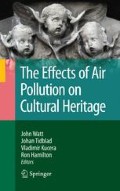The preceding chapters have, to a large extent, concentrated on an examination of the scientific methods of working out how much heritage materials are damaged by the environment that they are in. Science alone, however, does not tell us what to do about it. In the real world, the decisive factor is usually cost. There are many influences on the cost that we are prepared to accept for the given goods or services and many of those are linked to the value that we place on things. This chapter looks at some of the economic dimensions of air pollution damage to heritage.
Access this chapter
Tax calculation will be finalised at checkout
Purchases are for personal use only
Notes
- 1.
It should be noted that this approach gives complete sovereignty to the individual. Goods have value only because individuals want them, and are willing to trade money in order to get them. In particular, this definition of value rules out intrinsic values for goods that are independent of people’s preferences for those goods.
- 2.
Navrud and Ready (2002). Note also that price may also represent the goods’ marginal value to society depending on whether there are any externalities in consumption or provision, that is any impacts from its consumption on individuals other than the seller and the buyer.
- 3.
In extreme cases, Q0 could represent the complete loss of the building or monument, but complete elimination of a building or monument is rarely policy-relevant.
- 4.
In the economics literature, this measure of value is called the individual’s compensating variation for the change, or less precisely their consumer surplus.
References
References
CAFE (2008) Details of the CAFE Project Cost Benefit Analysis: http://www.cafe-cba.org/
“CULT-STRAT Project” – Assessment of Air Pollution Effects on Cultural Heritage – Management Strategies 2004–2007 Contract number: SSPI-CT-2004-501609.
DEFRA (2001) An Economic Analysis to Inform the Review of the Air Quality Strategy Objectives for Particles A Second Report of the Interdepartmental Group on Costs and Benefits http://www.defra.gov.uk/environment/airquality/panels/igcb/research/index.htm
ExternE (1999) DGXII (JOULE Programme) Externalities of Energy, ExternE Project, Report Number 7, Methodology: Update 1998. Holland, M.R. and Forster, D. (eds.).
Holland, M.R., Forster, D. and King, K. (1999) Cost-Benefit Analysis for the Protocol to Abate Acidification, Eutrophication and Ground Level Ozone in Europe. Report Number: Air and Energy 133, Ministry of Housing, Spatial Planning and Environment (MVROM), Directorate Air and Energy, ipc 640, P.O. Box 30945, 2500 GX The Hague, The Netherlands.
Holland, M, Hunt, A., Hurley, F. Navrud, S. and Watkiss, P. (2005) Final Methodology Paper (Volume 1) for Service Contract for carrying out cost-benefit analysis of air quality related issues, in particular in the clean air for Europe (CAFE) programme. AEA Technology.
Krupnick, A., Ostro, B. and Bull, K (2005) Peer review of the Methodology of Cost-benefit analysis of the Clean air for Europe programme.
Navrud, S. and Ready R.C. (2002) Valuing Cultural Heritage. Applying environmental valuation techniques to historical buildings and monuments. Edward Elgar publishing, UK. 279 pp.
Newby, P.T., Mansfield, T.A. and Hamilton, R.S. (1991) Sources and Economic Implications of Building Soiling in Urban Areas, Sci. Total Env., 100, 347–366.
Rabl, A. (1999) ‘Air Pollution and Buildings: An Estimation of Damage Costs in France,’ Environmental Impact Assessment Review 19, 361–385.
Sources of Additional Information
A useful primer on the theory of economic valuation, with case studies focussing on the heritage sector is:
Valuing Cultural Heritage by Navrud, S. and Ready R.C. Edward Elgar. 2002.279 pp.
“CULT-STRAT Project” – Assessment of Air Pollution Effects on Cultural Heritage – Management Strategies 2004–2007 Contract number: SSPI-CT-2004-501609.
Acknowledgements
The foundation for this chapter was the REACH Project, funded by the EU: Environment and Climate Programme under Topic 2.2.4. PROJECT No: ENV4-CT98-0708 (REACH). The major economic contributions to this project were made by Navrud and Ready on indirect costs (who have since published this work and more in their book, Valuing Cultural Heritage. Applying environmental valuation techniques to historical buildings and monuments, see below). The UK Building Research Establishment and their sub-contactor, Ecotec Ltd, examined the effects on the local area and the local economy. BRE, with ITAM in the Czech Republic also developed a great deal of the material on direct costs, building on earlier work by all partners in the REACH Project. We are grateful to Milos Drdácký in particular. We are also grateful to Mike Holland and Paul Watkiss, CAFE, for their contributions to this chapter based on their presentation to the MULTI-ASSESS Workshop, London 2004.
Author information
Authors and Affiliations
Corresponding author
Editor information
Editors and Affiliations
Rights and permissions
Copyright information
© 2009 Springer Science+Business Media, LLC
About this chapter
Cite this chapter
Watt, J., Navrud, S., Slížková, Z., Yates, T. (2009). Economic Evaluation . In: Hamilton, R., Kucera, V., Tidblad, J., Watt, J. (eds) The Effects of Air Pollution on Cultural Heritage. Springer, Boston, MA. https://doi.org/10.1007/978-0-387-84893-8_7
Download citation
DOI: https://doi.org/10.1007/978-0-387-84893-8_7
Published:
Publisher Name: Springer, Boston, MA
Print ISBN: 978-0-387-84892-1
Online ISBN: 978-0-387-84893-8
eBook Packages: Earth and Environmental ScienceEarth and Environmental Science (R0)

